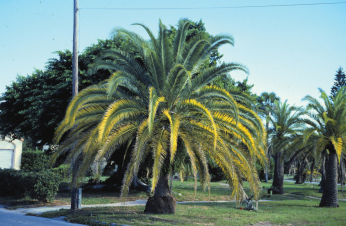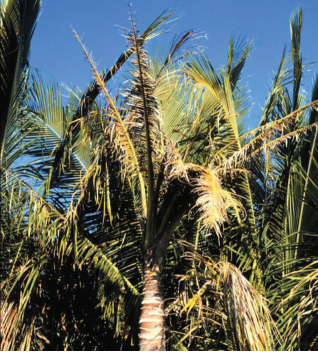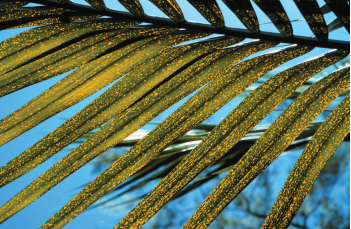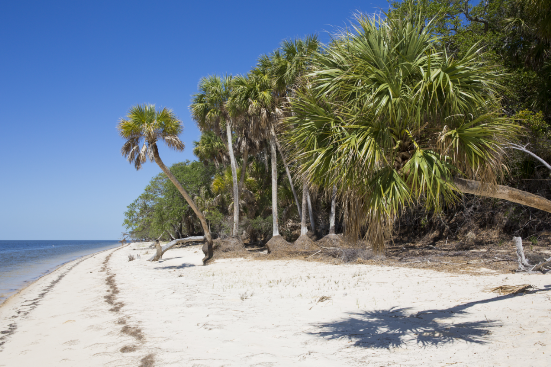
You know when you feel like you have a gremlin in your belly saying “Feeeeed meeee!”?
And how if the gremlin is ignored, it becomes more of an angry ROOOAR? Anyone in sight could get their head bitten off as a result. You know that feeling that goes from unsatisfied hunger to anger- that’s HANGRY!
Your plants can get hangry, too! Palm trees are especially picky, and they want certain nutrients in specific amounts in order to thrive in Florida.
Palm trees are considered the princes of the plant kingdom. Palms come with a crown, one prominent trunk, and a picky plantonality (my new word for plant personality). There are over 2600 species of palms worldwide, and let’s face it, palm trees are synonymous with beach vacation! People love palm trees, so palm trees are planted in non-native habitats all around the world. Palm trees are distinguished landscape specimens, and when the palm looks paltry, people notice.

There are 12 palm tree species native to Florida’s sandy soils, but we grow over 30 different species to transplant into landscapes around the state. While they are all beautiful, they are not all perfectly adapted to thriving in Florida’s climate, from sandy soils to sticky air. Even Florida’s native palms may struggle when transplanted into an urban landscape with urban soil conditions. Maintaining good fertility for your palm tree will keep your princely palm properly crowned.
Palm fertilizer for Florida has special qualities that can stick around in the sand and maintain balanced growth in the tree.
The first rule of palm fertilization is to fertilize for the palm, not the turfgrass. About 15 feet around every direction of the palm tree, spread a palm fertilizer on the turf to be accessed by the palm. It will keep the grass and the palm very happy! If you apply a turf fertilizer, you will add more nitrogen, but without the right amount of the other tasty nutrients. This forces the palm to push new growth, and since there are not enough nutrients in the soil, the palm will steal the nutrients from its own older leaves. The result is a self-induced nutrient deficiency in the older leaves which will look ratty. This brings us to rule two.
The second rule of palm fertilization is not about fertilizer at all. It is about pruning! If it is not dead, do not prune it off. OK, so you know a dead leaf right? A dead leaf is completely dead and brown. What about those bronzy, orangey, speckled, and highlighter yellow leaves on the bottoms of palm tree crowns that are definitely not dead, but look like total trash?

Those leaves are alive and they are critically important to the palm tree that looks like trash… they are the cure! Those leaves are keeping the palm tree alive because the new growth of the palm needs potassium and magnesium, but cannot get it from the soil, so it steals those nutrients from its own older leaves to relocate those nutrients in the new growth. The plant’s struggle to survive is undeniably amazing! Those living, but struggling leaves are the way of the plant communicating an issue to you, the landscaper, “Feeeeeed meee!” It is possible to correct some of these issues and it will take years, but it is a lot easier to just prevent your palms from ever getting too hungry by caring for them and fertilizing properly. In general, pruning green leaves off palms is like removing solar panels and nutrient reservoirs, while at the same time inviting palm diseases to dinner with an open door through the open wound where the green leaf was pruned.
The third rule of palm fertilization should actually be the first rule, but if you did not plant the palm there, you probably have very little control of the pH of the site. pH is a measure of acidity or alkalinity and in the soil, if the pH is not in the correct range for that plant, that plant will not take up the nutrients.

This should be considered when the landscape is designed, but too often, people just know what exotic palm tree they desire, plant it, and wonder why it never looked as good as the resort palms. Florida’s native palms, especially Sir Sabal palmetto, are already more tolerant of a wider range of pH, wet and dry seasonal fluctuations, high humidity, and hurricanes! Plus, our state Sabal palm is straight up steezy in its natural form – it looks lovely with layers of green, tan, yellow, and brown! Clearly, I crush on Sir Sabal. If you prefer other palm tree princes, make sure to test your soil first! If the pH is not in the ideal range for that palm tree, you need to adjust the pH with lime or sulfur, but you cannot reasonably decrease the pH if it is over 7.6 ish, even with the best sulfur products. The result is a constant micronutrient deficiency since those micros are difficult to take up in alkaline soils. The better idea is to plant the right plant in the right place, and select a Florida Friendly plant that will thrive in that soil condition.
The final rule is to apply 8-0-12-4 Mg palm fertilizer. University of Florida scientists determined the best balance of nutrients required by our palms in the landscape. Here is the fertilizer scoop:

- 100% of Nitrogen (N), Potassium (K), and Magnesium (Mg) needs to be in slow release form
- Micronutrients need to be in water soluble form [except Boron (B)]
- Does the fertilizer use kieserite as the Magnesium (Mg) source? That is usually a quick indication of a quality fertilizer product.
- March is a good time to fertilize your palm trees and other shrubs in the landscape. Feed with a quality palm fertilizer, and repeat in 2- 3 months.
- Fertilizer laws must be followed in your local county! In fact, UF/IFAS has adjusted recommendations to meet ordinance requirements and plant needs. Counties have different requirements.
A final note on palm fertility. Keep your plants happy and healthy by providing good nutrition. All too often palms with nutrient deficiencies are treated with pesticides, and the leaves that have the nutrition are chopped off because they look ugly. If you are going to treat a palm tree, you better know what you are treating because if these is no pest identified or no disease detected, you probably just need to fertilize with that good good 8-0-12-4 Mg.
More information about fertilizing palm trees:
Nutrient Deficiencies of Landscape and Field Grown Palms in Florida
Fertilization of Field- Grown and Landscape Palms in Florida
Not All Landscape Palm Fertilizers Are Created Equal
Ornamental Palms for Central Florida
 19
19
